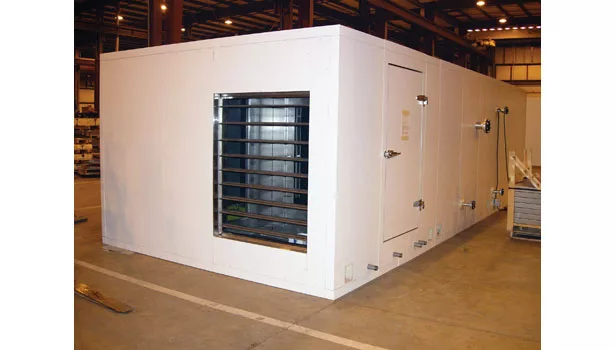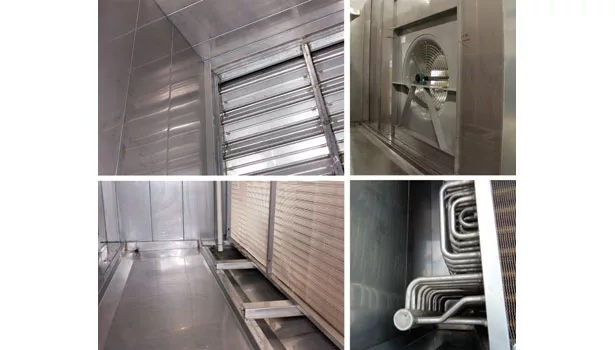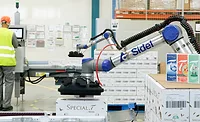Handle air with care





However, with the proper hygienic air handling equipment, it’s possible to reduce the count of these airborne menaces to a safe level. But what is a safe level? It depends on the application.
Exact and not-so-exact
Phoenix Air Systems’ whitepaper, The Importance of Clean Air suggests that even a small amount of unconditioned outside air, such as 1,000 cfm entering a processing room through an open door or unsealed cracks, contains more than 2 billion particles. The particles can include common dust and dirt, yeasts, molds, bacteria and other pathogens, each having an undesired effect on products processed in the room.
What defines how clean a processing room should be? ISO has defined nine classes of clean rooms based on particle size and concentration in its 14644-1 classification. For example, ISO Class 1 allows for a concentration of 10 particles/m3 where the particles are 0.1 micron in diameter. Class 2 allows for 100, and Class 3 for 1,000 particles/m3 of the same diameter.
Required air changes per hour can vary according to application. For some, 15-20 air exchanges per hour are sufficient, but cleaner facilities can require as many as 400-600 per hour with an air velocity of 0.3 m/s, according to Clean Air Solutions in Food Processing from VTT Publishing (#482). Alternatively, with a nominal flow rate of 0.5 m/s, 250 or more air exchanges per hour are needed.
Government and certification bodies offer advice, but not explicit details, on clean processing rooms. For example, a USDA/FSIS document entitled “Summary of Listeria monocytogenes (Lm) Compliance Guideline for Small and Very Small Meat and Poultry Plants that Produce Ready-To-Eat Products” suggests moist environments support Lm’s growth, and therefore, processors should clean cooling units and air handling units at a specific frequency and, during the cleaning process, stop all RTE production.
A Canadian publication, Health Products and Food Branch Inspectorate GMP Guidelines—2009 Edition, Version 2 (GUI-001), states that air quality is maintained through dust control, monitoring of pressure differentials between production areas and periodic verification and replacement of air filters. “The air handling system is well defined, taking into consideration airflow volume, direction and velocity. Air handling systems are subject to periodic verification to ensure compliance with their design specifications.”
“SQF and BRC only broach the subject of adequate ventilation in high-risk [areas] and in, say, cooking plants, like sauces and thermal processing,” says Tom Ambrosia, SQF and BRC certified auditor and consultant. The extent to which ventilation is covered in SQF is found, for example, in Section 9.2.9.1: “Adequate ventilation shall be provided in processing and product storage and handling areas.”
Establishing a clean processing room
“The type of hygienic air handling system to be purchased depends on how critical the process is,” says Alex Sumajin, SSOE Group senior mechanical engineer, senior associate. A processing or packaging area in the middle of the plant, with food openly exposed to the air, would be a Class 1 critical area according to Sumajin. Therefore, filtration in this area should be at least in the 90 to 95 percent efficiency range, which often calls for a HEPA (high-efficiency particulate air) filter. The area also would need to be part of an air-balanced system. According to FDA, HEPA filters have an efficiency range of 99.97 to 99.99 percent when tested using the dioctylphthalate (DOP) test with a particle size of 0.3 micron.
In its Guidance for Industry: Control of Listeria monocytogenes in Refrigerated or Frozen Ready-To-Eat Foods; Draft Guidance, FDA recommends using HEPA filters in areas where RF-RTE foods are processed or exposed. If this is not possible, FDA recommends the final filter in the hygienic air handling system have an efficiency of at least 90 to 95 percent at 1 micron as outlined in the ASHRAE standard 52.2-1999. In addition, airflow should have a positive pressure relative to the rest of the plant.
Facility creep disturbs airflow
For existing facilities, staying on spec with airflow is often a challenge. “When I go into existing plants, I’d say 80 percent of the time, airflow and pressurization are out of kilter,” says Ron Stewart, Shambaugh & Son mechanical engineering manager. “And it’s often expensive to fix that imbalance.” Though the plant may have had a positive pressure and correct airflow in its critical rooms at one time, adding on to the facility without careful attention to air handling can easily decrease air flow, and potentially change direction as well, according to Stewart.
“In systems where we had strategically designed the airflow and filtration, we see a phenomenon we call ‘facility creep’ happening all the time,” says Michael Steur, Hixson Architecture & Engineering director, business development. “Someone will come in and throw in a fan or exhaust fan, or they add a room without thinking how it affects the entire plant.”
“In a lot of the plants we visit, somebody will have an odor or heat issue, and the first solution is to turn on an exhaust fan,” says David Klenk, Hixson Architecture & Engineering project engineer. Because of situations like this, several plants Klenk visits have a negative airflow in critical spaces. “If everyone keeps turning on exhaust fans, they don’t realize they’re really bringing makeup air into the facility from places where they wouldn’t want that air.”
If a local exhaust fan is going to vent to the outside, makeup air should come from the room’s hygienic air handling system, according to Ed Escobar, Middough Inc. facilities mechanical department manager. This means that the system’s intake fan may need to speed up, and some outside air may need to be brought in and filtered so the hygienic airflow circuit is complete, causing no pressure or airflow changes. Escobar suggests that the supply fan in the air handling unit should be on a VFD, and controlled by a computer that senses the need for additional supply air.
Even when the system is set up properly, things can go awry. One plant that Luke Facemyer, Stellar director of design for refrigeration, visited had five units on the roof, and all were operating in cooling mode, but the facility was warmer than desired. When the maintenance crew visited the units, it found all the exhaust fans in each unit also running, moving the freshly cooled air out of the space. The issue often comes down to who owns the controls to the system.
Hygienic air handling equipment
“If you don’t have a hygienic air handling unit, you typically have a traditional ceiling-hung evaporator,” says Facemyer. These units still dominate freezers, coolers and hallways, and they typically have a coil, fan/motor and a filter—like a home air conditioner.
A hygienic air handling unit is often located on the roof, supported by independent structural elements, and supplies conditioned and filtered air via ducts to the space directly below. Sometimes, a hygienic unit is located at ground level between spaces in a plant or on mezzanines. Whether on the roof or on the ground level, these units are big enough to walk through and maintain. A typical unit supplies about 5 percent filtered outside air to pressurize the clean room space, according to Facemyer.
These units aren’t cheap, but depending on the manufacturer and model, they can offer two pluses for their users, according to Nevin Forry, senior product manager, value add products, Johnson Controls/Frick-NA. “First, you want your room pressurized [and clean] during process so if there are any leaks, the air is moving out.” Second, during cleanup and washdown of the interior process space, these units supply warm, dry air to the room to capture moisture and discharge it quickly into the atmosphere, thus speeding up the washdown phase, Forry explains. What’s important is the thoroughness of the drying-out process. When this phase is complete, condensation on the ceiling is nonexistent, so there won’t be any drips into food below.
“The food industry is looking at the hygienic air handler as an extension of the process room,” says Forry. Therefore, these systems and all their internal components are designed to withstand washdowns and often have SS interiors and a minimum of catch points. A catch point is any protrusion into the air space where particles can be trapped, causing a buildup of material that could contain biological contaminants.
“All air handlers have some type of cooling, heating and filtration, but a critical process unit goes beyond the scope of a unit that is satisfactory for an office building in terms of its filtration,” says Bruce Paulson, Evapco vice president. These units also are double-walled with insulation between; no insulation is exposed to the airstream. Drain pans are in every section; the walls and ceilings are watertight. Maintenance workers can get in and clean the unit and change filters when necessary, according to Paulson.
“For hygienic air systems, sometimes an option is to provide an automated CIP system that will automatically wash down the interior of the unit at programmable intervals,” adds Escobar.
“Beyond the double walls, the other challenge is how you design the interior and install the components like the coils, blowers, filter mountings, etc.,” says Paulson. “You need to be able to access them, clean and inspect using swab tests.” Drain pans should be solid welded with radius corners. Coil and blower mountings have to be placed so maintenance staff can get around and under them. The design also has to allow ready accessibility for easy cleaning, according to Paulson.
Beyond a simple, manual control that some processors like, most systems have PLC-based control and industrial networking options. They can be integrated with process control, refrigeration and HVAC systems, especially if processors want coordinated operation of all these systems. In addition, air handling systems should automatically accommodate changes in airflow and pressure caused, for example, by opening and closing doors.
How much filtration?
Typical hygienic air handling units use two or three filters. Sometimes two are grouped together and considered a single pre-filter (see diagram on page 60). They have an efficiency anywhere from 30 to 65 percent. The final filter is normally rated at 95 percent (MERV 14) unless a HEPA filter is required.
There is some argument about the level of filtration needed. Some argue for HEPA filters, and these are suited to sterile filling areas, says Paulson. However, processors must realize the addition of very-high-efficiency MERV or HEPA filters place an additional load on the blowers and their motors, requiring more power to maintain the desired velocity and throughput.
A viable alternative would be to employ a more localized, point-source air cleaning system at the application needing the filtration, according to Richard Carrow, John W. Danforth Company general manager. The advantage of a local system is that it doesn’t change the requirements of—or place an extra burden on—the larger air handling system. And the local system can be run with a three-stage HEPA filter for the critical applications that need the filtering.
Forry says most process rooms only need 95 percent final filtration, and beyond that can be expensive and unnecessary. “While the most common contaminant would not be captured in the 95 percent filters themselves, these organisms are not free floating and become arrested when the particle they’re attached to becomes entrapped in the filter,” says Forry. “Filtration does not sterilize the product; it only makes the air nonthreatening.”
While filtering is important, the direction of airflow is critical. “With respect to overall airflow in a process plant with multiple rooms, it is desirable that air cascade room to room in a path opposite that of product flow,” adds Forry. “This means air flows from cleaner rooms to less-clean rooms.” With the controls on today’s air handling systems, managing airflow direction isn’t difficult to accomplish, according to Forry.
The addition of ultraviolet lamps in the air handling system can present a couple of benefits, depending on what the processor wants to accomplish. Facemyer sees them go into about one-third of installations, and they’re typically reserved for high-end filtration systems in cases requiring deactivation of bacteria and viruses as they pass through the system. However, UV lamps are used for another purpose.
“The ultraviolet [lamps] are fantastic for keeping coils clean,” says Klenk. UV may cleanse the air as it goes by, but at a linear airflow of 2,000 ft./min., it may not be that effective unless a high-level of UV wattage is used. However, applying UV to the coil is a good idea, because the bacteria sticking to the coil are exposed long enough to render them inactive. The lamps can also stay on when the fans are not running.
“UV actually works by piercing through the cell wall, deactivating the DNA,” says David Skelton, Lumalier business partner. ASHRAE ran tests and published in 2008 that UV applied to the coils inactivates spores, bacteria and viruses on the coil and prevents the formation of biofilm, which can reduce coil efficiency by as much as 22 to 25 percent if it’s not removed chemically or via UV light.
Clean thoughts
Older facilities without a hygienic air handling system could be building up biological reservoirs of dangerous bacteria, mold and viruses, according to David Hedman, Thermapure CEO. When lab tests keep coming back positive for these contaminants, it might make sense to do a thermal pasteurization of the facility so the processor starts with a clean slate prior to installing a hygienic air handling system. Older plants without a hygienic air handling system can sometimes be upgraded. If they can, it’s important to consider the burden a hygienic air handling system can put on a structure. A system can weigh anywhere from three to 17 tons. Units over nine-feet wide are commonly shipped in multiple sections, according to Forry.
The details of locating these units in existing plants or new facilities is a job for architects and engineers as there are several structural engineering issues. Some of these involve opening existing structures to add steel support columns since most roofs won’t support the weight, according to Dennis Carroll, manager, Johnson Controls/AcuAir application engineering. However, the added columns need the proper foundation to support them. Sometimes existing load-bearing walls make the job easier by providing support on one end. Other supports may still be required if the distance to the next load-bearing wall is too great a span to support the weight.
Duct work is another issue, especially in older facilities where it already exists or where it is difficult to run new ducting without concealing it. Ductwork is often considered an extension of the air handling system in the process area, meaning that it needs special consideration for cleaning. According to Stewart, galvanized ductwork is good enough for some applications, but some owners require SS inside and out because of the cleaning agents used in washdowns.
As with the interior of the air handling unit, some applications require exposed ductwork with a smooth, easily cleanable surface, according to Chris Schaffer, Hixson project engineer. “We’ll [specify] welded SS ductwork for some of these spaces, and then we’ll put access doors in the ductwork, so they have the ability to open them during washdowns.” In this case, ducting has to be slightly sloped with a drain at one end. Duct sections must be welded with no screws that could become catch points.
“We really try to keep all ductwork out of the actual space itself,” says Hixson’s Klenk. “We would have essentially a walkable ceiling, which in many cases would be like a raised metal panel ceiling, and have all the ductwork and piping located above the ceiling. All we would have is the penetration through the ceiling with a supply drop box, a welded engineered piece.”
The location and quantity of diffusers and returns are as much art as they are science, according to Carroll. The airflow needs to be sufficient for the cleanup/washdown phase of operation, yet provide the right temperature in the space without creating drafts where people are working. When done properly, the design of the complete air handling system should allow workers to be as comfortable in a 40°F room with low humidity as they would in a 50°F room with high humidity. And the system will help keep the food clean.
For more information:
Tom Ambrosia, Safe Quality Food Services, 570-925-2614, tomambrosia@gmail.com
Alex Sumajin, SSOE Group, 419-255-3830, asumajin@ssoe.com
Ron Stewart, Shambaugh & Son, 260-487-7777, rstewart@shambaugh.com
David Klenk, Hixson Architecture & Engineering, 513-241-1230, dklenk@hixson-inc.com
Michael Steur, Hixson Architecture & Engineering, 513-241-1230,
Ed Escobar, Middough Inc., 630-756-7000, escobar@middough.com
Luke Facemyer, Stellar, 904-260-2900, lfacemyer@stellar.net
Nevin Forry, Johnson Controls/Frick-NA, 717-259-9755, nevin.forry@jci.com
Bruce Paulson, Evapco, 507-446-8005, bpaulson@evapcomn.com
Richard Carrow, John W. Danforth Company, 866-581-1347
David Skelton, Lumalier, 901-774-5771, dskelton@lumalier.com
Chris Schaffer, Hixson Architecture & Engineering, 513-241-1230,
David Hedman, Thermapure, 805-641-9333, dhedman@thermapure.com
Dennis Carroll, Johnson Controls/AcuAir, 251-665-0247, dennis.r.carroll@jci.com
Looking for a reprint of this article?
From high-res PDFs to custom plaques, order your copy today!







